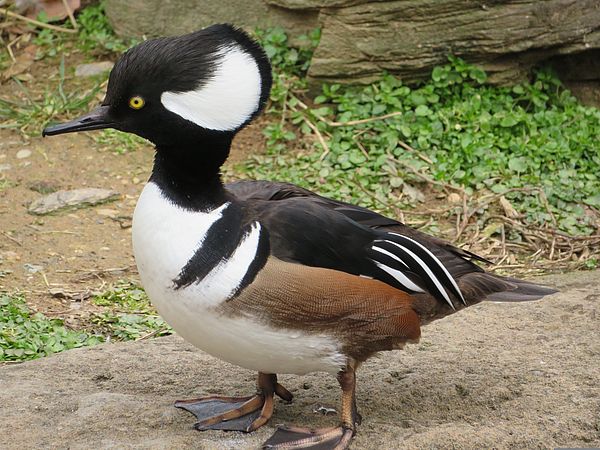Hooded Merganser – Fish-eating Diving Duck
Article by Ava Steenstrup
Hooded Mergansers, affectionately known as “Hoodies,” are the smallest of the three merganser species occurring in North America. The adult male Hooded Merganser in breeding plumage has a large white crest surrounded by black that can be raised or lowered like a fan.
The top of its head, neck and back are all black, with tawny sides, and his breast is white with two black bars on each side. Its long, narrow, serrated bill is black and its eyes are yellow. Female hooded mergansers are grayish-brown overall, lighter below and darker on the back with a reddish-brown crest. The upper bill is black-edged with orange and the lower bill is yellow.
Their habitat is mainly forested wetlands, small bodies with fresh water such as ponds, lakes, streams, slow moving rivers, and small estuaries where there is ample emergent aquatic vegetation, but they can also be found on larger bodies of freshwater, marshes, and can frequent protected saltwater bays, especially in winter.
Mergansers are the only ducks that specialize in eating fish. Although they feed mostly on small fish, their diet also consists of mollusks, amphibians (tadpoles and frogs), crustaceans (especially crayfish), vegetation, and aquatic insects.
Hooded Mergansers are renowned for their diving skills and catching prey underwater as well as being one of the fastest flying ducks. These ducks can stay submerged for up to two minutes when chasing fish underwater, propelled by their webbed feet. In addition, they have a nictitating membrane or additional set of eyelids that act as a protective shield to help them see prey underwater. Hooded Mergansers take flight by running across the water’s surface and flapping its wings. In flight, they hold their head, bill, body and tail straight and can fly at speeds approaching 50 mph.
Hooded Mergansers are almost always seen with birds of the same species. They can be seen in pairs or in small groups and, outside of the breeding season, may gather in large groups to roost at night. They are generally quiet but will emit low grunting or croaking sounds to communicate with each other.
Did you know?Males are called drakes, females are hens, and young are ducklings. Ducklings in the water may gather in a tight compact group resembling a swimming muskrat. This instinctive behavior may deceive aerial predators such as hawks.

